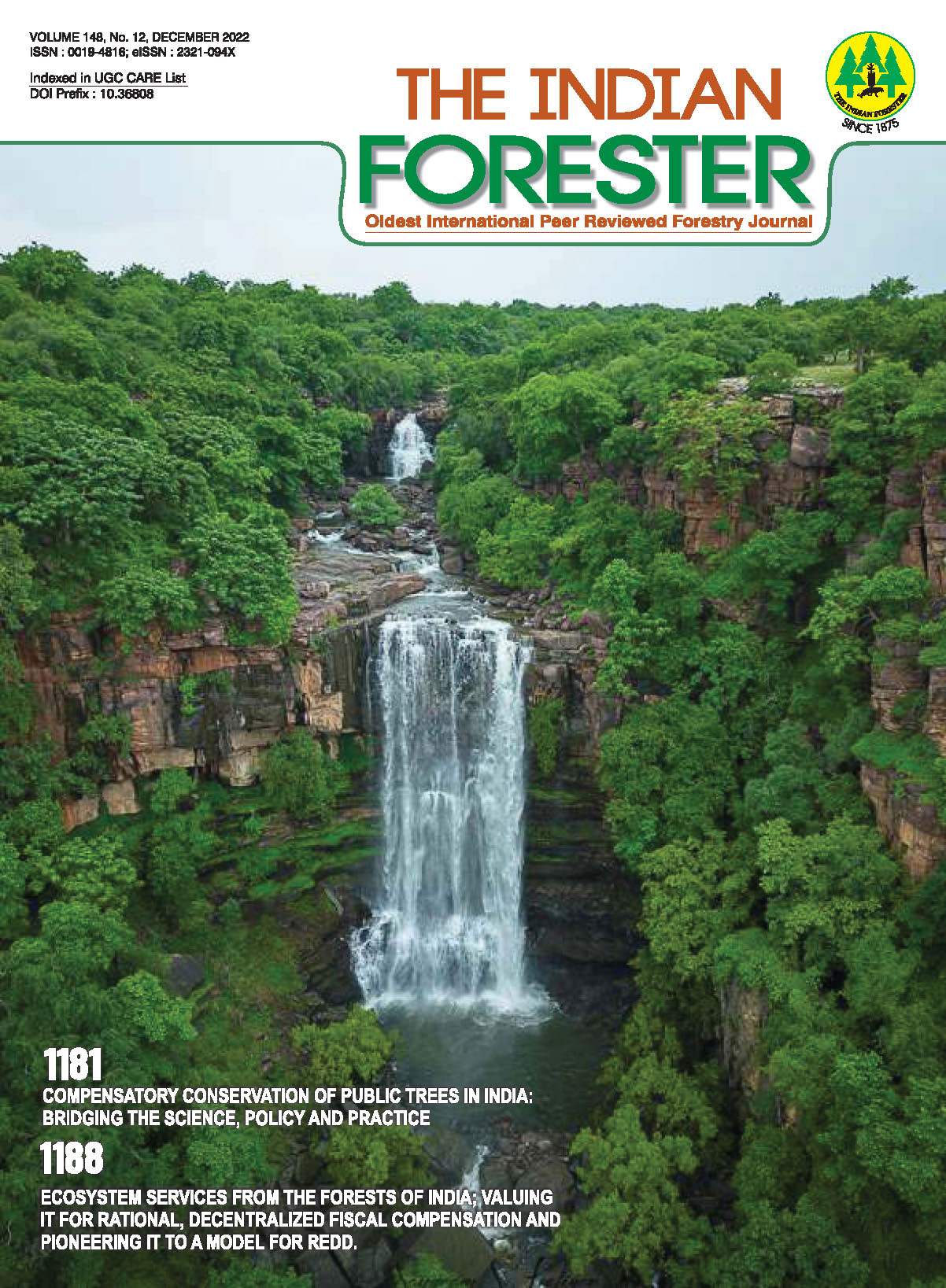Site suitability analysis for the critically endangered Aconitum heterophyllum in Alpine regions of Uttarakhand using Analytic Hierarchy Process
DOI:
https://doi.org/10.36808/if/2022/v148i12/163188Keywords:
A. heterophyllum, Site suitability, Alpine regions, Analytic hierarchy process, Critically endangered.Abstract
Aconitum heterophyllum (Ranunculaceae) is an ayurvedic medicinal plant used as a main ingredient in many Ayurvedic herbal formulations. The rising pharmaceutical demand has led to extensive exploitation of this endangered species from wild and rendered the species into miserable situation. For the effective conservation and habitat restoration of the species, the Analytic Hierarchy Process (AHP) method was used for the assessment of suitable sites in alpine region of the Uttarakhand. The AHP analysis revealed 567 km2 area as highly suitable, 485 km2 area as suitable and 914 km2 area as moderately suitable for the growth of A. hetrophyllum in the Uttarakhand. Most of the highly suitable sites are close to 3700-4000 m and lies in northern grassy slopes. The AHP analysis also exhibit that the temperature, rainfall and moisture have a high impact on the distribution of A. hetrophyllum.
References
Akınc H., Ozalp A.Y. and Turgut B. (2013). Agricultural land use suitability analysis using GIS and AHP technique. Comput Electron Agr., 97: 71-82.
Boroushaki S. and Malczewski J. (2008). Implementing an extension of the analytical hierarchy process using ordered weighted averaging operators with fuzzy quantifiers in ArcGIS. Comput Geosci., 34(4): 399-410.
Cengiz T. and Akbulak C. (2009). Application of analytical hierarchy process and geographic information systems in landuse suitability evaluation: a case study of Dümrek village (Çanakkale, Turkey). Int J Sust Dev World, 16(4): 286-294.
Chen S.M., Yang M.W., Lee L.W. and Yang S.W. (2012). Fuzzy multiple attributes group decision-making based on ranking interval type-2 fuzzy sets. Expert Syst Appl., 39(5): 5295-5308.
Feizizadeh B, Roodposhti M.S., Jankowski P., Blaschke T. (2014). A GIS-based extended fuzzy multi-criteria evaluation for landslide susceptibility mapping. Comput Geosci., 73: 208-221.
Garfi M., Tondelli S. and Bonoli A. (2009). Multi-criteria decision analysis for waste management in Saharawi refugee camps. J. Waste Manag., 29(10): 2729-2739.
Goraya G.S., Ved D.K. (2017). Medicinal plants in India: an assessment of their demand and supply. Dehradun: Ministry of Ayush.
IUCN Parks for Life: Report of the IVth. (1993). World Congress on National Parks and Protected Areas. IUCN.
Kala C.P. (2010). Assessment of availability and patterns in collection of Timroo (Zanthoxylum armatum DC.): a case study of Uttarakhand Himalaya. Medicinal Plants-Int. J. of Phyto. Rel. Indus., 2(2): 91-96.
Kaul M.K. (1997). Medicinal plants of Kashmir and Ladakh: temperate and cold arid Himalaya. Indus publishing.
Lal J.B., GulatiA.K., Bist M.S. (1991). Satellite mapping of alpine pastures in theHimalayas.Int. J.RemoteSens.,12(3):435-443.
Malczewski J. (1999). Visualization in multicriteria spatial decision support systems. Geomatica., 53(2): 139-147.
Miller C.C., Burke L.M. and Glick W.H. (1998). Cognitive diversity among upper-echelon executives: implications for strategic decision processes. Strateg Manag J., 19(1): 39-58.
Nautiyal S., Rao K.S., Maikhuri R.K., Negi K.S., Kala C.P. (2002). Status of Medicinal Plants on way to Vasuki Tal in Mandakini Valley, Garhwal Himalaya, Uttaranchal.
Pamucar D., Yazdani M., Montero-Simo M.J., Araque-Padilla R.A. and Mohammed A. (2021). Multi-criteria decision analysis towards robust service quality measurement. Expert Syst Appl., DOI: 10.1016/j.eswa.2020.114508.
Parimala M. and Lopez D. (2012). Decision making in agriculture based on land suitability-spatial data analysis approach 1. J. Theor. Appl. Inf. Technol., 46(1): 17–23.
Rau M.A. (1975). High altitude flowering plants of West Himalaya. Howrah: Botanical Survey of India.
Rawat G.S. (2005). Alpine Meadows of Uttaranchal: Ecology, Landuse, and Status of Medicinal & Aromatic Plants. Bishen Singh Mahendra Pal Singh, Dehradun.
Saaty T.L. (1997). A scaling method for priorities in hierarchical structures. J Math Psychol., 15(3): 234-281.
Saaty T.L. (1980). Multicriteria Decision Making: The Analytic Hierarchy Process. McGraw-Hill, New York (2nd impr. 1990, RSW Publishing, Pittsburgh).
Saaty T.L. (2008). Relative measurement and its generalization in decision making why pairwise comparisons are central in mathematics for the measurement of intangible factors the analytic hierarchy/network process. RACSAM-Revista de la Real Academia de Ciencias Exactas, Fisicas y Naturales. Serie AMatematicas., 102(2): 251-318.
Saaty T.L. and Vargas L.G. (1980). Hierarchical analysis of behavior in competition: Prediction in chess Behav Sci., 25(3), 180-191.
Sahani N. (2019). Application of analytical hierarchy process and GIS for ecotourism potentiality mapping in Kullu District, Himachal Pradesh, India. Environ Dev Sustain., 1-25.
Samant S.S., Dhar U., Palni L.M.S. (1998). Medicinal Plants of Indian Himalaya: Diversity, Distribution, Potential Value. Nainital: Gyanodaya Prakashan.
Singh D.K. and Hajra P.K. (1996). Floristic diversity. In: Changing perspectives of biodiversity status in the Himalaya. British High Commission Publication 23-38.
Ved D.K., Kinhal G.A., Ravikumar K., Prabhakaran V., Ghate U., Shankar V.R., Indresha J.H. (2003). CAMP Report: Conservation assessment and management prioritization for medicinal plants of Himachal Pradesh, Jammu, and Kashmir, and Uttarakhand. In Workshop FRLHT. Shimla, Himachal Pradesh, Bangalore, India.
Zinko U., Seibert J., Dynesius M. and Nilsson C. (2005). Plant species numbers predicted by a topography-based groundwater flow index. Ecosystems, 8(4): 430-441.
Downloads
Downloads
Published
How to Cite
Issue
Section
License
Unless otherwise stated, copyright or similar rights in all materials presented on the site, including graphical images, are owned by Indian Forester.





